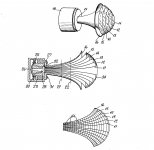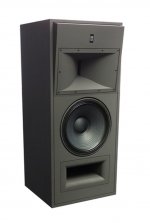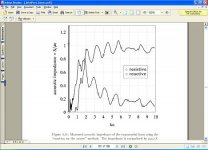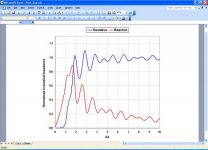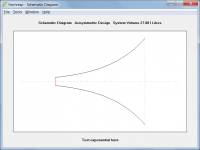Pano, I'm curious if your impressions of compression drivers used too low is relevant only to shallow types? of which camplo is not considering using. Also was it in a home setting? There is obviously a certain point where you are indeed too low, but my point is not that loading and directivity of a given horn are mutually exclusive, but rather that maintaining directivity too low DOESNT MATCH THE WOOFER. Look at the off axis measurements of a horn and ask yourself at what frequency the polars of that horn match the woofer. It's on the left most edge. Hence, you don't want a horn too large for the desired xo.
Mark, i see. Thanks for explaining that. Maybe a synergy is really the best solution to what he's trying to accomplish.
Mark, i see. Thanks for explaining that. Maybe a synergy is really the best solution to what he's trying to accomplish.
It seems to me that the ideal design for what the OP wants is a Danley type design. It has been shown to be readily constructed with good results. It's not the "ultimate" IMO, but then what people seem to want in this thread is very different than what I want.Putting the woofers inside the horn would indeed negate the drawbacks, but he's not planning a synergy.
Please define excellent loading and what the differences are between a salmon and a OSWG that makes the salmon superior as far as loading.
Seems to me I see loading as a criteria but frankly don't see any clear reason why loading would be preferred over directivity control over the usable bandwidth.
Rob :}
I agree completely.
Yes, maybe this thread needs a technical definition of what is meant with "loading"...
People don't even seem to understand what "loading" is! Yes loading will lower excursion somewhat, but to what purpose. It is wrong to think that lower excursion always means lower distortion. Unless the device is operating at its limits nonlinearity is not an issue. Drivers are linear until they are not, and this is unlikely to happen in a home environment. Distortion is not a linear function of level, it comes on very quickly and is a substantial problem if it is allowed to happen. But the right design won't allow this to happen in which case distortion and loading are not issues.
Directivity problems on the other hand are always an issue.
And then there is diffraction, which is a linear function of level, but has a very nonlinear perception. This means that a device with diffraction will "sound bad" at higher levels even if the driver is operating completely linear. Thus, how does one tell if the "bad sound" is the driver excursion or the diffraction? I contend that subjectively it is not possible.
Last edited:
A
- Resistance control (R > X ) improves transient response
The first and second argument in favour of good loading are the same thing, which makes good directvity (control) a clear winner.
However, this doesn't mean good loading is irrelevant.
But in an exponential horn this is not True. AT cutoff X > R, so by this logic, an OS would have the better transient response because its X is lower than in other devices. But at any rate I don't buy this argument as significant (or correct) anyways.
Yes, loading is not completely irrelevant, but then the OS does have "good" loading and I would contend quite comparable to any device of the same size. The high "loading" aspects that people point to are false artifacts that occur in the Webster solution that don't actually occur in reality. So much of the erroneous ideas that I hear stem directly from a blind faith in Webster. His approach was wrong, we all know that, so why place so much importance on something that is so suspicious.
Last edited:
Mark, i see. Thanks for explaining that. Maybe a synergy is really the best solution to what he's trying to accomplish.
Personally, I absolutely see this as the case. I hope Camplo goes down that road.
Just remember that synergy devices don't look "cool". And we all know how closely tied appearance and sound quality are.
Personally, I absolutely see this as the case. I hope Camplo goes down that road.
Just remember that synergy devices don't look "cool". And we all know how closely tied appearance and sound quality are.
To be honest, it was one of the first ideas suggested, I was afraid of the construction of a synergy, then, though now, I just see a box made around a horn with some holes cut in it... if I'm implementing a 3d printer, and building a custom horn, I don't see why I wouldn't be able to build a synergy, one day, as well.
How far are you taking this idea? You guys suggesting I build a synergy using the axi2050 and the AE Drivers? It sounds crazy enough that I'd entertain it lol.
Axi2050's used in home on a large horn should be able to meet up with the woofers nicely around 300hz. I don't see the point of a synergy with a driver that can go that low.
Put the woofers in low tuned ported boxes and call it a day. After you get an idea what you're working with, then consider optimizing your room absorption/diffusion characteristics. Keep your measurement gear handy and learn how to see your problems by moving your mic around the room in real time. You'll see most of the mess in the low-mids and bass response.
You have the drivers to make a simple but very effective hi-quality/output 2-way. Your main concern should be the horn for the Axi. Something like a seos 30 or 36 if it exists would be real nice.
Put the woofers in low tuned ported boxes and call it a day. After you get an idea what you're working with, then consider optimizing your room absorption/diffusion characteristics. Keep your measurement gear handy and learn how to see your problems by moving your mic around the room in real time. You'll see most of the mess in the low-mids and bass response.
You have the drivers to make a simple but very effective hi-quality/output 2-way. Your main concern should be the horn for the Axi. Something like a seos 30 or 36 if it exists would be real nice.
Last edited:
..and right around that cross you have axial resonances to push down, and below that a floor and ceiling...I just see a box made around a horn with some holes cut in it...
..and right around that cross you have axial resonances to push down, and below that a floor and ceiling...
Poking fun at my over simplification? I just meant the construction of a synergy isn’t as intimidating as it once was.
Axi2050's used in home on a large horn should be able to meet up with the woofers nicely around 300hz. I don't see the point of a synergy with a driver that can go that low.
Put the woofers in low tuned ported boxes and call it a day. After you get an idea what you're working with, then consider optimizing your room absorption/diffusion characteristics. Keep your measurement gear handy and learn how to see your problems by moving your mic around the room in real time. You'll see most of the mess in the low-mids and bass response.
You have the drivers to make a simple but very effective hi-quality/output 2-way. Your main concern should be the horn for the Axi. Something like a seos 30 or 36 if it exists would be real nice.
Ctc spacing is being brought up but I let go of the idea of winning that battle a long time ago. The last horn we looked at is around 23” tall so we are in the same boat as a 350hz jmlc/tractrix and the lower the xover the better it is for ctc spacing anyway so really what can you do?
I was thinking sealed for both woofers.
The discussion has been around the Seos type horn vs a salmon type horn. One camp favoring the cd horn for wide treble/mid and another favoring salmon horn for sound quality...the last horn discussed is 35-40” wide and ~24” tall. A Seos 30 or “36” is in the same ball park height wise so no gains to be had on ctc.
It's not really "used too low" but used too loudly. There is a sort of "I hear the driver" sensation in shallow horns (waveguides) that I don't hear in deeper horns. In deeper horns I hear the recording, I don't hear the driver. It might have to do with frequency caused excursion, that seems plausible.Pano, I'm curious if your impressions of compression drivers used too low is relevant only to shallow types?
It's a subtle effect to be sure. Some people don't notice it or maybe don't mind it, but I do because it sounds artificial. With shallow horns the sound of the speaker mechanics can get in the way of the recording. IMO.
But in an exponential horn this is not True. AT cutoff X > R, so by this logic, an OS would have the better transient response because its X is lower than in other devices.
The limitations of Webster's theory were known by some scientists, even in the 1920's. It became widely prevalent due to inclusion in prominent literature throughout the 20th century and for a lack of published alternative horn theories, such as the undisclosed works in the archives at Bell Labs.
The loading vs directivity comparison is from Bjørn Kolbrek and It's not for me to question his knowledge.
Last edited:
So after 5092 posts is the answer to the initial post a yes or a no?
Appreciate all of the super smart responses. Is great to see so many replies from people that actually know WTF they are talking about. I too love the scientific mathematical explanations provided. Usually I have an issue with popular HiFi views vs scientific/mathematical fact. But now I find myself on the other side of the discussion. How does all of the science/math based arguments translate audibly? So many problems with horns. Lets just dump them. I guess that's not the point.
Appreciate all of the super smart responses. Is great to see so many replies from people that actually know WTF they are talking about. I too love the scientific mathematical explanations provided. Usually I have an issue with popular HiFi views vs scientific/mathematical fact. But now I find myself on the other side of the discussion. How does all of the science/math based arguments translate audibly? So many problems with horns. Lets just dump them. I guess that's not the point.
My original reason for reading this thread was I was searching for insight as to building a 2 way or 3 way speaker using a cone woofer with a horn mid/tweeter. Marketing likes to push 3 way is better than 2 way. 4 way is better than 3 way. More is better. To me "make it as simple as possible, but no simpler". My question has to do with the 3 octave horn rule. Is it a problem to do a compression driver/horn from 800Hz to 15KHz with a single compression driver/horn that the manufacturer produces a response plot claiming it can? Besides the math what is the audible cararcteristics? Less crossover issues vs excessive driver/horn BW?
Less well known than the OSWG, but no less interesting is Dr. Geddes' Phase Plug Patent, which brought me to the idea to extend the phaseplug into a "Phaseguide".
As is the case with most loudspeaker concepts, something similar (though not the same) was patented by Amparex in 1958.
As is the case with most loudspeaker concepts, something similar (though not the same) was patented by Amparex in 1958.
Attachments
My question has to do with the 3 octave horn rule. Is it a problem to do a compression driver/horn from 800Hz to 15KHz with a single compression driver/horn that the manufacturer produces a response plot claiming it can? Besides the math what is the audible cararcteristics? Less crossover issues vs excessive driver/horn BW?
800-15k? Sure.
The Calpamos by Tony Gee is an example, another "slightly more expensive", but similar 2-way is the Strauss MF-2...
Pardon me, it's now MF-2.1.
The specs seem too good to be true, but the designer has a very good reputation in the high-end mixing/mastering industry at stake.
I have yet to encounter a negative comment on the predessor, which looks identical (apart from the woofer) and has been around since 2000.
SE-MF-2.1
Drivers:
- 2” compression driver, metal alloy diaphragma, neodymium magnet circuit
- 15” LIT woofer, coated paper cone, neodymium magnet circuit
Sensitivity: 93 dB / 1 W / 1m
Impedance: 8 Ohm
Power: 200 W RMS
Frequency range: 23 Hz – 26 KHz (-* 6 dB)
Crossover frequency: 400 Hz
Distortion THD: < 0.3 % (93 dB / 1m / 100 Hz – 26 KHz)
Dispersion: 90° horizontal, 40° vertical
Weight: 110 kg / 220 lbs
Dimensions: height 1200 mm, width 530 mm, depth 490 mm
Attachments
Last edited:
The high "loading" aspects that people point to are false artifacts that occur in the Webster solution that don't actually occur in reality.
???
Attachment 1 - Measured normalised throat acoustical impedance for the axisymmetric exponential horn specified below.
Attachment 2 - Predicted normalised throat acoustical impedance for the same horn.
Attachment 3 - Horn profile.
Test horn:
Throat cross-sectional area = 20.27 cm^2
Mouth cross-sectional area = 2307.22 cm^2
Axial length = 55.90 cm
Radiating into half-space (2.0 x Pi steradians solid angle)
(The simulation results were exported to Excel and converted to show values of ka rather than frequency along the x-axis, to make it easier to directly compare the predicted and measured data).
Attachments
David, your sim seems to confirm the common conception regarding the good loading properties of exponential horns (irrespective of Webster's theory).
Another interesting horn related topic is mode coupling (courtesy of B. Kolbrek).

Another interesting horn related topic is mode coupling (courtesy of B. Kolbrek).

Last edited:
your sim seems to confirm the common conception regarding the good loading properties of exponential horns
More importantly, the actual measured results also confirm it 🙂.
- Home
- Loudspeakers
- Multi-Way
- Is it possible to cover the whole spectrum, high SPL, low distortion with a 2-way?
